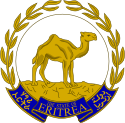
Back جبهة التحرير الإريترية Arabic Front d'Alliberament d'Eritrea Catalan Eritreische Befreiungsfront German Eritrea Liberiga Fronto Esperanto Frente para la Liberación de Eritrea Spanish Front de libération de l'Érythrée French החזית לשחרור אריתריאה HE Eritrejski oslobodilački front Croatian Fronte di Liberazione Eritreo Italian エリトリア解放戦線 Japanese
This article needs additional citations for verification. (December 2012) |
| Eritrean Liberation Front | |
|---|---|
| Tigrinya: ተጋደሎ ሓርነት ኤርትራ Arabic: جبهة التحرير الإريترية Italian: Fronte di Liberazione Eritreo | |
 Flag of the ELF adopted from the flag of the Eritrean-Ethiopian federation | |
| Founders | Idris Mohammed Adem |
| Leaders | Idris Mohammed Adem (1960–1975) Ahmed Mohammed Nasser (1975–1982) |
| Dates of operation | 1960–1981 |
| Country | Eritrea |
| Headquarters | Kassala, Sudan (1965) |
| Active regions | Eritrea (1960–1981) |
| Ideology | Eritrean nationalism |
| Allies | |
| Opponents | |
| Battles and wars | |
 |
|---|
| Constitution (not enforced) |
| Elections |
|
|
The Eritrean Liberation Front (ELF; Tigrinya: ተጋደሎ ሓርነት ኤርትራ; Arabic: جبهة التحرير الإريترية; Italian: Fronte di Liberazione Eritreo), colloquially known as Jebha, was the main independence movement in Eritrea which sought Eritrea's independence from Ethiopia during the 1960s and the early 1970s.
After the Ethiopian Empire violated a 1952 UN resolution that guaranteed Eritrea the right to an autonomous government, the ELF was established in 1960 in order to waged an armed struggle for independence. Under Emperor Haile Selassie, the Ethiopian government banned Eritrean political parties, free press and right to assembly. During 1961, the ELF began the Eritrean War of Independence.[1] Idris Muhammad Adam and other Eritrean intellectuals founded the ELF as a primary Pan Arab movement in Cairo, but the first act of armed resistance was led by Hamid Idris Awate. Over the course of the 1960s, the ELF was able to obtain support from Arab countries such as Egypt and Sudan. However, tensions between Muslims and Christians in the ELF along with the failure of the ELF to ward off Ethiopia's 1967–1968 counter offensive internally fractured the ELF, causing it to split.
By the mid 1970s, the ELF and the Eritrean People's Liberation Front (EPLF), an ideologically Maoist liberation movement, were the key liberation movements in Eritrea. The EPLF ultimately overtook the ELF as the primary Eritrean independence movement by 1977, and the ELF was subsequently defeated in 1981.
- ^ Harnet, Mekalh (pseud ) (1983). "Reflections on the Eritrean Revolution". Horn of Africa. 6 (3): 3–15.